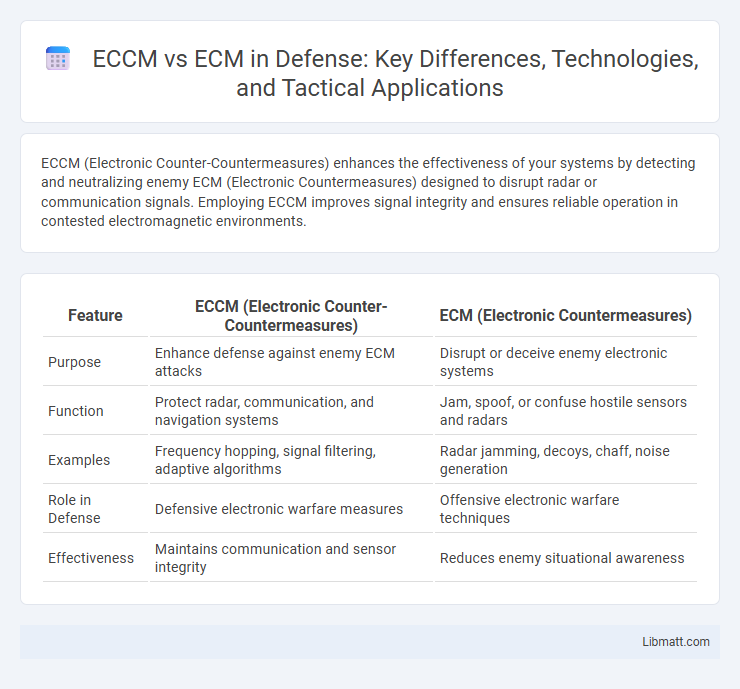ECCM (Electronic Counter-Countermeasures) enhances the effectiveness of your systems by detecting and neutralizing enemy ECM (Electronic Countermeasures) designed to disrupt radar or communication signals. Employing ECCM improves signal integrity and ensures reliable operation in contested electromagnetic environments.
Table of Comparison
| Feature | ECCM (Electronic Counter-Countermeasures) | ECM (Electronic Countermeasures) |
|---|---|---|
| Purpose | Enhance defense against enemy ECM attacks | Disrupt or deceive enemy electronic systems |
| Function | Protect radar, communication, and navigation systems | Jam, spoof, or confuse hostile sensors and radars |
| Examples | Frequency hopping, signal filtering, adaptive algorithms | Radar jamming, decoys, chaff, noise generation |
| Role in Defense | Defensive electronic warfare measures | Offensive electronic warfare techniques |
| Effectiveness | Maintains communication and sensor integrity | Reduces enemy situational awareness |
Understanding ECM: Definition and Functions
Electronic Countermeasures (ECM) involve using electronic signals to deceive or disrupt enemy radar, communication, and targeting systems, thereby protecting your assets from detection and targeting. ECM techniques include jamming, deception, and interference, which reduce the effectiveness of hostile radar and missile guidance systems. Understanding ECM functions helps enhance defense strategies by identifying vulnerabilities and deploying appropriate countermeasures against electronic threats.
What is ECCM? Key Concepts Explained
ECCM (Electronic Counter-Countermeasures) refers to techniques and technologies designed to protect your electronic systems from Electronic Countermeasures (ECM), which aim to disrupt or deceive radar and communication signals. Key concepts of ECCM include signal encryption, frequency hopping, and advanced filtering to ensure reliable detection and communication despite enemy jamming efforts. Implementing ECCM enhances system resilience and maintains operational effectiveness in contested electromagnetic environments.
The Purpose of ECM in Modern Warfare
Electronic Countermeasures (ECM) aim to disrupt or deceive enemy radar, communication, and targeting systems to protect your forces from detection and attack. ECM employs techniques like jamming, spoofing, and signal interception to neutralize threats and enhance battlefield survivability. Effective ECM increases operational success by impairing adversaries' electronic capabilities in modern warfare environments.
ECCM Strategies: Countering Electronic Threats
ECCM strategies enhance your defense by improving radar and communication systems to resist electronic countermeasures (ECM) aimed at jamming or deception. Techniques such as frequency hopping, signal encryption, and adaptive filtering counteract ECM threats by making electronic attacks less effective. Implementing ECCM ensures your electronic assets maintain operational integrity despite adversaries' electronic warfare efforts.
How ECM and ECCM Interact on the Battlefield
ECM (Electronic Countermeasures) disrupt or deceive enemy radar and communication systems to protect forces from detection and targeting. ECCM (Electronic Counter-Countermeasures) are techniques and technologies designed to resist, negate, or mitigate the effects of ECM, ensuring your radar and communication systems remain operational and reliable. The dynamic interaction between ECM and ECCM on the battlefield creates a continuous cycle of action and reaction, where both sides constantly adapt to maintain electronic superiority and effectiveness.
Key Technologies in ECM and ECCM Systems
Key technologies in Electronic Countermeasures (ECM) include jamming signals, deception techniques, and stealth technologies designed to disrupt or deceive enemy radar and communication systems. Electronic Counter-Countermeasures (ECCM) leverage advanced signal processing, frequency hopping, and adaptive filtering to protect friendly systems from ECM interference and maintain operational effectiveness. Both ECM and ECCM systems continuously evolve through integration of artificial intelligence and machine learning to enhance detection, response, and survivability in electronic warfare environments.
Real-World Applications: ECM vs ECCM Scenarios
Electronic Countermeasures (ECM) are widely used in military aviation and naval operations to disrupt enemy radar, communications, and missile guidance systems, providing a tactical advantage by degrading hostile electronic capabilities. Electronic Counter-Countermeasures (ECCM) are essential for ensuring the resilience and reliability of your radar and communication systems against ECM attacks, maintaining operational effectiveness in contested environments. Real-world scenarios include ECM-equipped fighter jets jamming enemy radar during air combat and ECCM-enabled missile defense systems preserving target tracking despite adversary attempts to interfere electronically.
Advantages and Limitations of ECM and ECCM
Electronic Countermeasures (ECM) enhance defense by jamming, deceiving, or disrupting enemy radar and communication systems, offering advantages such as immediate threat neutralization and versatility across multiple platforms. However, ECM limitations include vulnerability to advanced signal processing techniques and potential interference with friendly systems. Electronic Counter-Countermeasures (ECCM) improve radar and communication resilience by countering ECM tactics, ensuring continued operation in contested environments, though they can be costly to implement and may increase system complexity.
Future Trends in Electronic Warfare Tactics
Future trends in electronic warfare tactics emphasize the growing importance of Electronic Counter-Countermeasures (ECCM) to counteract increasingly sophisticated Electronic Countermeasures (ECM). ECCM advancements leverage AI-driven signal analysis and adaptive frequency hopping to maintain communication integrity and radar functionality amidst hostile interference. Your ability to integrate next-generation ECCM technologies will be crucial for maintaining tactical advantages in evolving electromagnetic battlespaces.
Conclusion: The Evolving Battle Between ECM and ECCM
Electronic Counter-Countermeasures (ECCM) represent advanced defensive techniques designed to neutralize or mitigate the effects of Electronic Countermeasures (ECM), which aim to disrupt or deceive radar and communication systems. As ECM technologies continue to evolve with sophisticated jamming, deception, and spoofing tactics, ECCM strategies advance through adaptive signal processing, frequency hopping, and enhanced encryption protocols. The ongoing battle between ECM and ECCM drives continuous innovation in electronic warfare, emphasizing the need for resilient systems capable of maintaining operational effectiveness in contested electromagnetic environments.
ECCM vs ECM Infographic

 libmatt.com
libmatt.com